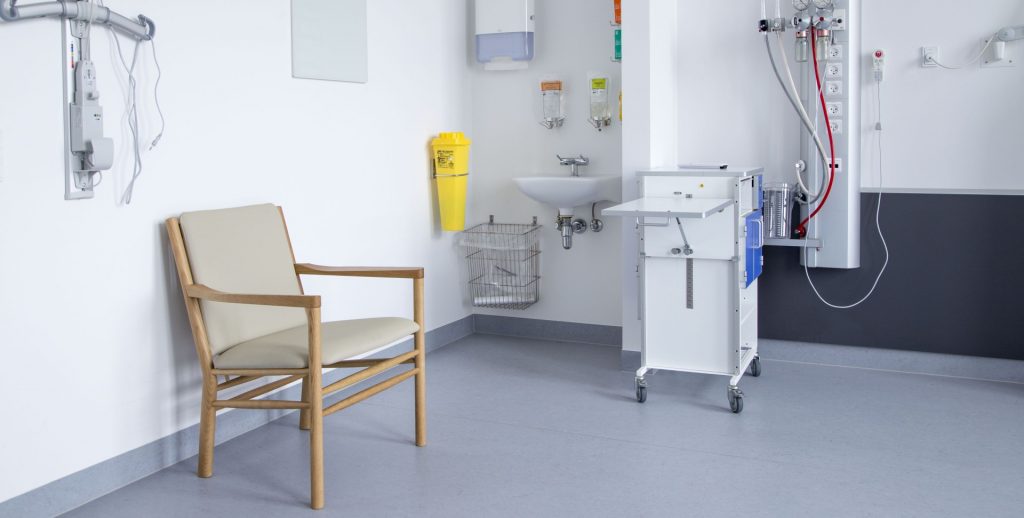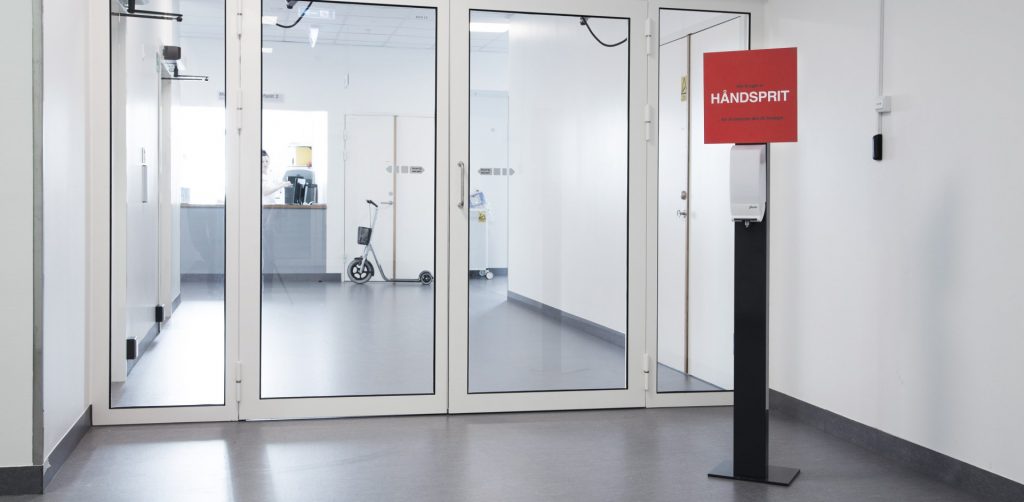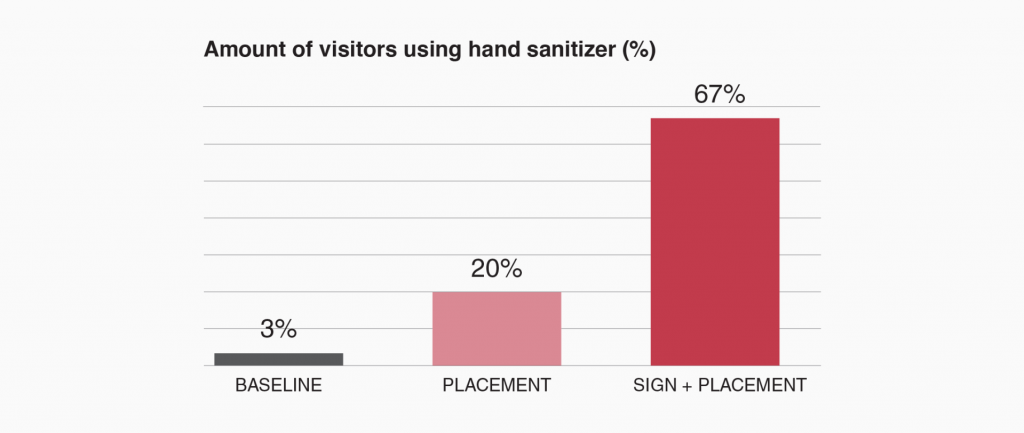
Hospital-acquired-infections (HAI’s) are a costly affair to patients and society as a whole. Acquiring a hospital infection creates additional suffering for the patient and it may at worst lead to death [1]. Prolonged hospitalisation due to HAI’s also represents a massive financial burden to health care systems around the world. Improving hand hygiene behaviour in hospitals is among the most promising ways of preventing such HAI’s [2]. This brief blogpost reports on a recent field experiment aimed at testing a simple nudge [3] aimed at improving hand hygiene amongst visitors.
In Denmark, it has been estimated that 1 in every 10 hospitalised patients acquire an infection during their hospitalisation [4]. These incidents drive additional health care costs and the Danish Health Care System spends nearly 1 billion DKK on a yearly basis accounting for the costs of prolonged hospitalisation [5].
The hospital environment is rich on bacteria, even one’s that only thrive within this specific environment. These bacteria are a major threat to vulnerable and weakened patients causing prolonged hospitalisation and, at worst, death. Therefore it is of utmost importance to try and eliminate the transmission of bacteria and hand hygiene is the single most important factor in reducing the transmission of HAI’s [6] [7].
A lot of effort has been made to improve health care workers’ hand hygiene compliance (HHC) and far less has been done in order to maintain high levels of HHC among visitors. To our knowledge there is only one published investigation into this matter, which in return yielded an increase in HHC from 0.52% to 11.67% [8].
As the nudge approach dictates [9], the authors of this paper sat forth to develop a simple nudge and test this in a field experimental setting. The main objective was to investigate how to further increase visitors’ use of hand disinfectant in a real-world setting.
The Intervention
The use of hand sanitizer is an active way of supporting your relative in the recovery process. Throughout all of the investigation it was assumed that hospital visitors care about the well being of their hospitalised loved ones and want to help setting them on their feet again. Hence, what we were interested in was to remove the obstacles that might possibly drive the non-compliant hand hygiene behaviour causing a gap between the visitors’ good intentions towards their relatives and the visitors’ actual behaviour.
The final intervention was made up of the three nudge-functions, placement, colour and normative message.

Fig. 1 Original placement of the hand sanitizers.
Placement
One of the first things we noticed at Gentofte Hospital was the placement of the hand sanitizers. At the Medical Department all hand sanitizers were primarily located above the sinks inside the hospital wards (See Fig.1). The choice of using hand sanitizer is thereby offered at a seemingly late point in time competing against the choice of approaching one’s hospitalized relative.
The first part of the intervention included a new placement of the hand sanitizer. We introduced a freestanding hand dispenser at the very beginning of the Medical Department to ensure the least amount of competing stimuli in the environment.
Colour
The hand sanitizers had a low degree of salience in the original setup. The hand sanitizer packaging was transparent which made it blend in with the surrounding environment (See Fig. 1). This visual attribute made the hand sanitizer less likely to catch the visitors’ attention when entering the ward.
In order to work around the transparency problem we introduced a red sign right above the freestanding hand sanitizer as the second part of the intervention (See Fig. 2). In the natural world the colour red is the most common signalling colour [10]. Consequently, the colour red is a substantial visual stimulus better at directing our attention compared to other colours. Another aspect of the colour red, is the different associations the colour brings along with it. The colour red is used in traffic to catch drivers’ attention. In traffic red means that you have to stop as opposed to the colour green that invites you to move on. We wanted to integrate this association into the layout of the sign (See Fig. 2).

Fig. 2 The new placement of the hand sanitizer combined with the red sign.
Normative Message
The final function of the intervention was a text message printed onto the red sign. It stated “Here we use HAND DISINFECTANT in order to protect your relative”. The text message on the sign was made up of two different elements:
“Here, we use HAND DISINFECTANT”
The first part of the text was constructed as a normative message. Thus, we expected that it would inform the visitors about the most accepted behaviour in relation to hand hygiene at the hospital. People who visit the hospital might find it difficult to estimate the right kind of behaviour in this particular context.
“… in order to protect your relative”
The second part of the text was used to make the consequences of hand hygiene compliance more tangible to visitors, by giving them a plausible reason as to why they should engage in positive hand hygiene behaviour.
Experimental Design
Our field experiment consisted of three different conditions with 30 visitors observed in each condition (N=90). First, the baseline condition was tested in order to determine the general level of hand hygiene compliance. Secondly, in our placement condition we employed a freestanding hand dispenser at the very beginning of the department. Thirdly, the sign+placement condition made use of the new placement as well as introducing the sign on top of the hand dispenser. The data was gathered by direct observation during five concecutive days at Gentofte Hospital.
The Results

Fig. 3 The results from the field experiment.
In the wake of the field experiment we ended up with the following results. In the baseline condition only 3% of the visitors used hand disinfectant. Introducing the new placement for the hand dispenser resulted in 20% of the visitors using hand disinfectant. Finally, with the combination of both the new placement and the sign, hand hygiene compliance reached a level of 67% (See Fig. 3).
The groups showed an overall significant difference x2(df= 2, N = 90) = 14.45, p = .0007). Using a second chi-square, we found that the “sign+placement” group, were significantly different from the other two (x2(df= 1, N = 90) = 11.72, p = .0006). Using a bonferroni correction for multiple comparisons on both tests, they maintain significance at p < 0.01.
The results from the field experiment at Gentofte Hospital clearly indicates that it is possible to increase hand hygiene compliance among visitors by means of changing the default placement and providing a salient sign using a positively framed message. In a broader perspective our results suggests that the employment of behavioural insights is a valuable tool to improve visitors’ hand hygiene compliance.
Experiment done by Simon Carøe Aarestrup (1), Frederik Moesgaard (2), Johannes Schuldt-Jensen (3)
1 Junior Researcher, iNudgeyou
2 BSc, Business Administration & Psychology, CBS.
3 Junior Researcher, iNudgeyou,
SCA & FM: nudge development and experiment, JSJ: data analysis.
References:
- [1] WHO. (2009). on Hand Hygiene in Health Care First Global Patient Safety Challenge Clean Care is Safer Care. World Health, 30(1), 270. doi:10.1086/600379.
- [2] Boyce, J. M., & Pittet, D. (2002). Guideline for hand hygiene in health-care settings: recommendations of the Healthcare Infection Control Practices Advisory Committee and the HICPAC/SHEA/APIC/IDSA Hand Hygiene Task Force. American journal of infection control, 30(8), S1-S46.
- [3] Hansen, P. G., & Jespersen, A. M. (2013). Nudge and the manipulation of choice: A framework for the responsible use of the nudge approach to behaviour change in public policy. Eur. J. Risk Reg., 3.
- [4] Pedersen, K. M., & Kolmos, H. J. (2007). Hospitalsinfektioner – en samfundsøkonomisk udfordring. Ugeskrift For Læger, (November), 4135–4138.
- [5] Jepsen, O. B. (2000). Hvad Koster Sygehus-infektioner? CAS-NYT, Copenhagen: Statens Serum Institut, (85).
- [6] Boyce, J., & Pittet, D. (2002). Guideline for hand hygiene in healthcare settings. Journal of the American College of Surgeons, 30(8), 1–46. doi:10.1016/j. jamcollsurg.2003.08.016.
- [7] Statens Serum Institut. (2015). Håndhygiejne. Retrieved February 10, 2016, from http://www.ssi.dk/ Smitteberedskab/Infektionshygiejne/Retningslinjer/ Generelle Infektionshygiejniske Retningslinjer/ Haandhygiejne.aspx.
- [8] Birnbach, D. J., Nevo, I., Barnes, S., Fitzpatrick, M., Rosen, L. F., Everett-Thomas, R., … & Arheart, K. L. (2012). Do hospital visitors wash their hands? Assessing the use of alcohol-based hand sanitizer in a hospital lobby. American journal of infection control, 40(4), 340-343.
- [9] Hansen, P. G., Skov, L. R., & Skov, K. L. (2016). Making Healthy Choices Easier: Regulation versus Nudging. Annual review of public health, (0).
- [10] Kuniecki, M., Pilarczyk, J., & Wichary, S. (2015). The color red attracts attention in an emotional context. An ERP study. Frontiers in human neuroscience, 9.

